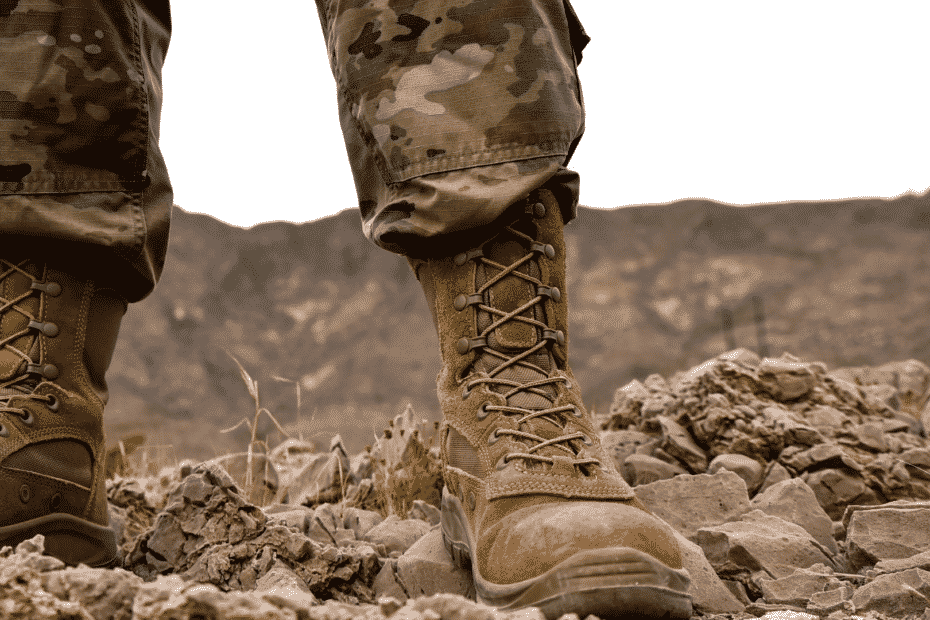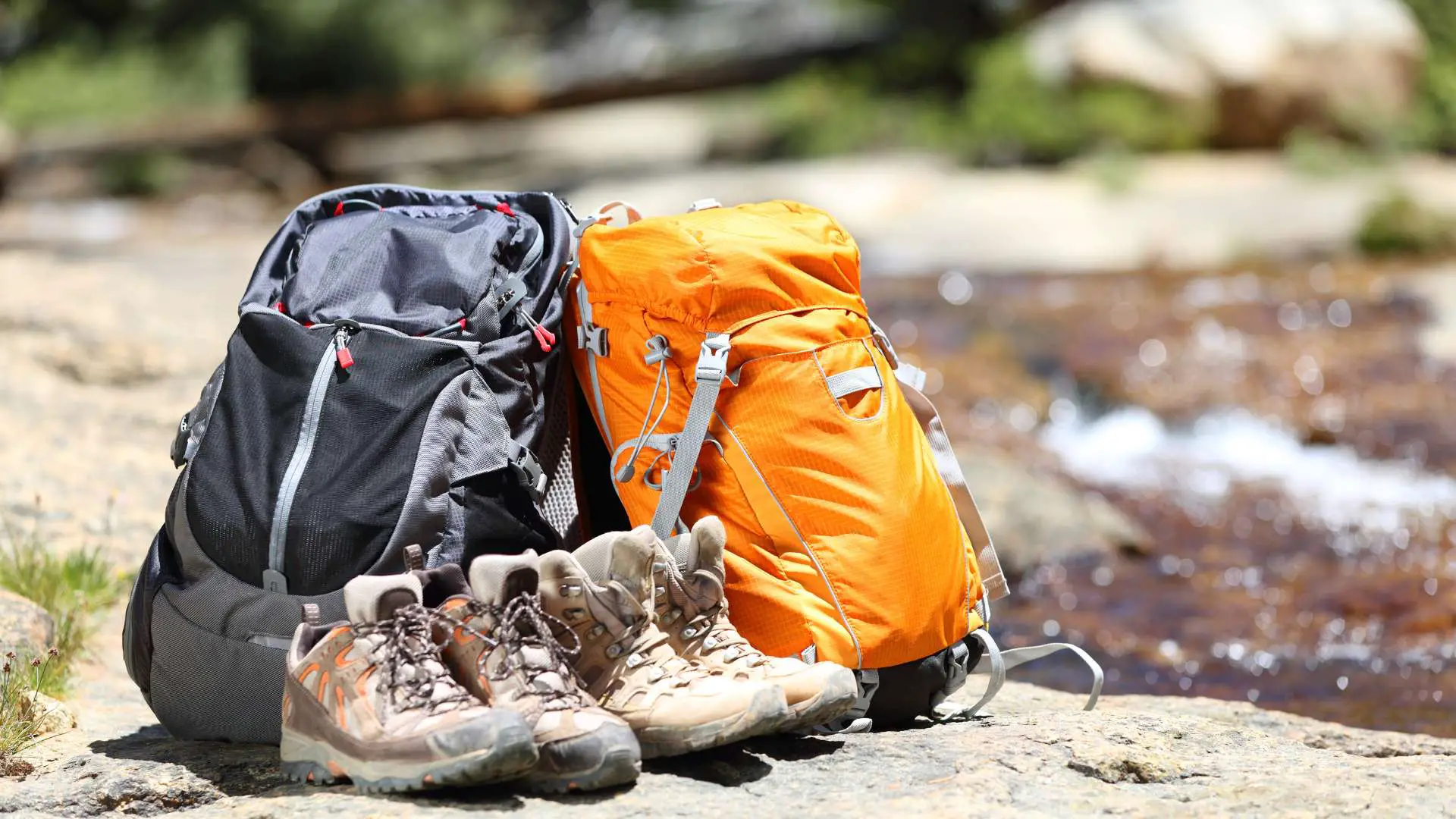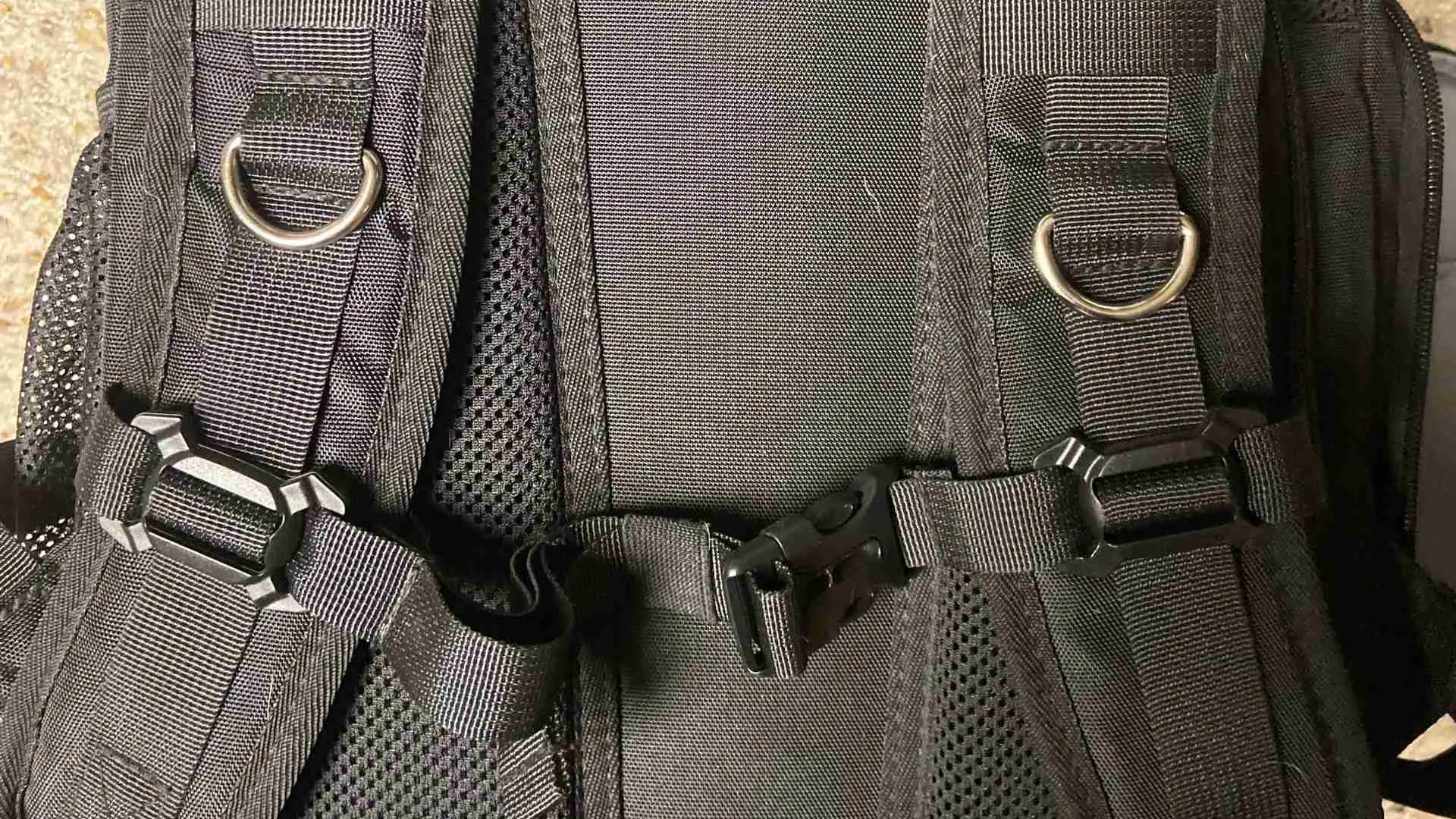The standard issue military combat boot and a traditional hiking boot have a lot in common. There are a few differences, like added ankle support, but it’s almost like the government designed combat boots specifically for hiking. It seems like the perfect fit, but are military combat boots good for hiking and backpacking?
Military combat boots are great for hiking and backpacking. They’re extremely durable, comfortable, flexible, water resistant, quick drying, and designed to be used on rough terrain carrying a heavy load. The raised uppers make them a little bit heavier, but you can definitely use military combat boots for hiking.
Military boots were designed for combat, but think about the terrain they’re used on. Soldiers that are wearing combat boots need to be able to handle both on and off-road applications. Trekking through the mountains in the middle east isn’t that different than hiking through the backwoods of a national park (ignoring combat).
The military testing process designed the standard issue combat boot so it could be used on dirt trails. There are a few differences between military boots and typical hiking shoes, but the design is very similar to hiking or backpacking boots.
Table Of Contents
Should You Use Tactical Military Boots For Hiking?
Military boots are designed to be used on long distances “Ruck Marches” with a heavy load. So, You can definitely wear combat boots instead of a traditional hiking boot! If you’re unfamiliar with military marches it’s essentially a long distance timed hike with a heavy pack.
The government may have designed military boots for combat, but they’re perfect for hiking. There’s really only one difference between military boots and hiking boots. Military boots usually have taller uppers so they’re slightly heavier. That might be a problem at first, but you’ll get used to it over a few weeks.
The United States Military standard for a ruck march is a 12 mile hike through difficult terrain with a 45 pound pack (or heavier), which sounds an awful lot like hiking with a backpack. It’s a faster pace, but it’s similar to backpacking.
Any type of military spec compliant boots will be durable enough for the average hiker, but the high ankles make them slightly heavier. That’s great from a durability/safety standpoint, but you will notice a slight weight difference. There are a few disadvantages (check below) versus traditional hiking shoes, but here are a few of the main benefits.
9 Reasons Why Tactical Military Boots Are Perfect For Hiking
- Military boots are extremely durable and should hold up for 1000s of miles.
- Made out of a combination of leather and nylon to reduce weight while increasing flexibility.
- Strong nylon/leather “Upper” protects your ankles without feeling stiff.
- Cushioned insoles and flexible “Upper” is extremely comfortable with minimal impact on speed and agility.
- Water-Resistant nylon side panels improves airflow reducing foot sweat.
- The nylon shell resists water without causing excessive sweating.
- Unlike most mid-calf boots, combat boots are extremely flexible so they move with the terrain.
- Made to meet military cost standards, so you can purchase an extremely durable pair of boots at a reasonable price.
- The semi-aggressive tread pattern works well in both urban and backcountry settings.
Tactical military boots are great for hiking, but I wouldn’t recommend them for everybody. I currently wear a pair of Bates Ranger Boots, but I’ll still wear my trail running shoes when it’s really hot outside or I plan on getting wet.
What Are The Best Military Boots For Hiking?

I hate to say it, but I’ve become a bit of a boot collector over the years. My wife prefers the term hoarder, but my closet is lined with like 20+ pairs of boots. She would kill me if she ever took the time to add up the prices.
At first I was wanted to take a picture of my old beat up boots all lined up, but I figured the older pictures of when I first bought them would look a little bit better. They were used in construction for years so they’re covered in paint, dirt, blood, cement, and who knows what else.
There are 3 major players when it comes to traditional combat boots. The United States Military issues Bates, Belleville and Mcrae’s as their standard issue combat boot. It doesn’t matter which brand of boots you buy since they all meet or exceed US Military quality standards.
- Bates Boots: I’ve tried a few different brands over the years and I think Bates offers the best combination of comfort and durability. I’ve put at least 5,000 miles in a pair of Bates Rangers and they’re still holding up. My wife just bought me a new pair for Christmas (new boots are pictured above), but I’ll keep the old ones to use in the mud.
- Bellville Boots: Bellville boots seem to be the most durable out of the 3 major brands, but the price reflects that. I really like my Bellville C300’s, that I bought a few years ago while doing construction. They’re extremely comfortable and will last a very long time.
- Mcrae Boots: Mcrae boots are typically cheaper than Bates and Bellvilles, since they’re the most commonly issued boot in the US Military. You can sometimes find a pair of McRae Mil-Spec boots for $80-$130 if you hit a good deal. My Mcrae Legacy Boots aren’t as pretty as my hey aren’t as my Bates/Bellville’s but they’re lighter and meet military specifications.
- Other Brands: There are lots of other boot manufacturers that meet military specs. I’ve heard good things about the Oakley Light Assaults and Reebok Rapid Response among my friends in law enforcement. Any boot that meets military specs are high quality so go with whichever pair fits your budget.
Are There Any Downsides To Hiking In Military Boots?
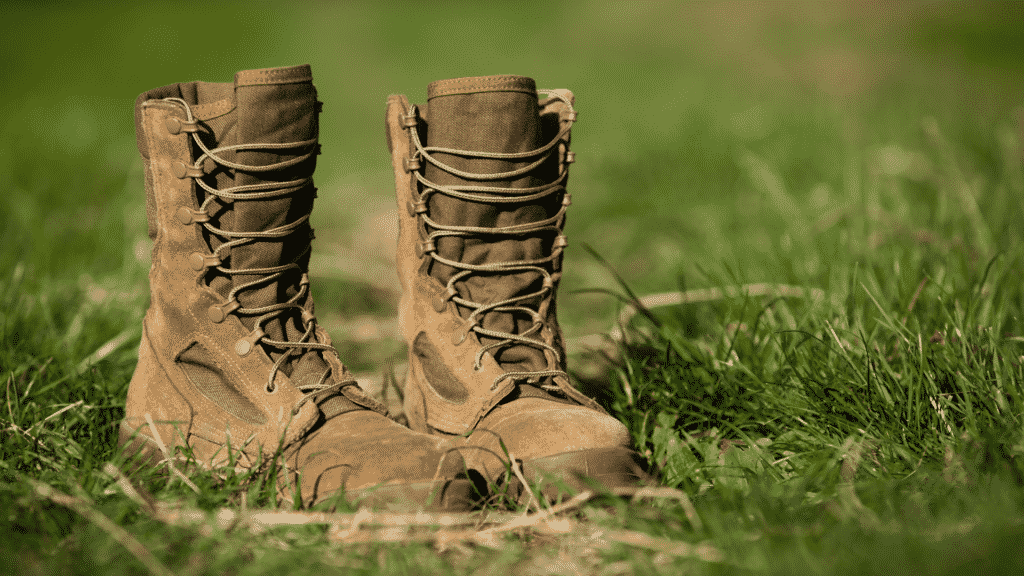
- Tall Uppers Increase Weight: Tall uppers are great for preventing injury, but it adds weight to your feet. There’s an old saying that hikers swear by: “one pound on your feet equals five pounds on your back”. That might not be perfectly accurate, but will notice a difference hiking in heavy boots.
- No Cheap Options: Hiking boots come in a wide range of prices. Cheap boots might cost $50-$70 and expensive products are well over $300. Mil-Spec combat boots need to meet military testing and price standards so they’re all in the $100-$150 range.
There’s not much you can do about price, but don’t worry about the added weight! It might take 2-3 weeks, but your body will quickly adjust to the weight difference. Reduce your pack load for a little while and shorten your hiking mileage until they feel comfortable. Start off by wearing them on day hikes with a lighter pack and gradually add weight/mileage as you get used to them.
Our bodies are really good at adapting our muscles when we put them to the test. In the hiking community, this is commonly referred to as building your hikers legs or trail legs, but researchers call it neuromuscular adaptation. It’s when your body activates the nerve cells in your muscles to deal with added stress until more muscle forms (6-8 weeks).
Hiking In Military Boots vs Traditional Hiking Boot
There isn’t much of a difference between combat boots and traditional hiking boots. Combat boots have taller “Uppers”, but the rest of the boot shares similar properties. They protect your ankles from scrapes/cuts, sprains, and breaks, but it does add a few oz to the boot.
Combat boots are great for hiking, but traditional hiking boots might be a better fit. You might want to go with a low/mid ankle hiking boot if you only plan on hiking flat well maintained trails. There’s a very small risk of ankle injury so a lighter shoe might be a better option.
Don’t Compare A Tactical Boot To Trail Running Shoes
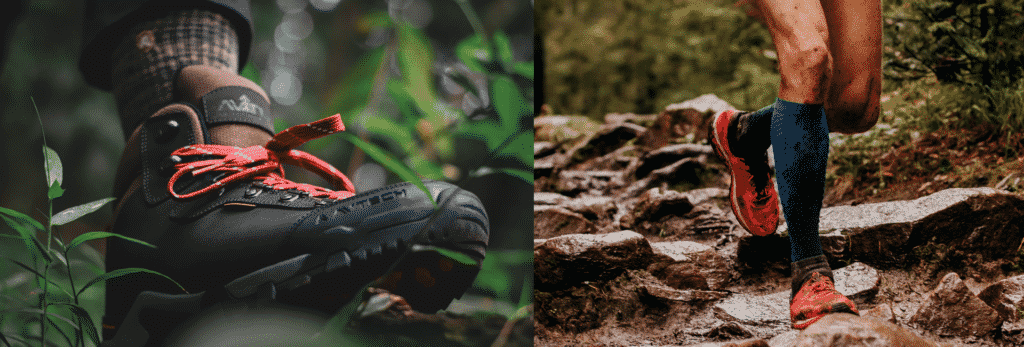
When you think about hiking shoes, most people picture a standard mid-ankle hiking boot. A typical pair of hiking shoes has rugged-looking, durable design, that’s waterproof/water-resistant. They’re great for stability and ankle support, but lots of hikers are switching over to trail runners.
I love trail runners, but it’s like comparing a minivan to a sports car. They serve a similar purpose, but they’re made for completely different things. Trail running shoes are designed to be light with added grip for off-road usage and drainage ports along the sides. They’re not even water-resistant since they have drainage ports and use quick-drying materials.
There’s no way to compare a tactical boot to what’s essentially an all terrain running shoe. I love wearing combat boots on a hike, but there’s definitely a place for trail runners. If you’re not worried about your ankles, you should definitely consider a trail running shoe. Hiking through tough terrain may warrant wearing combat boots.
Why I Hike In Tactical Military Hiking Boots
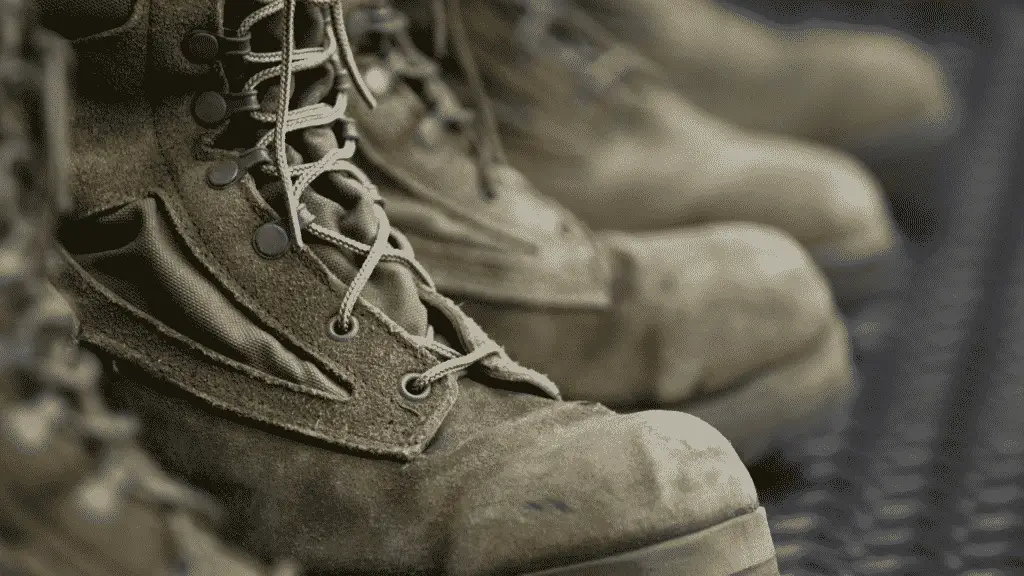
Military combat boots are a great alternative to traditional hiking boots. They’re designed for military use, but they use similar construction to hiking boots. Tactical boots use a combination of leather and water-resistant nylon just like hiking boots.
The leather is used in the bottom of the boot to improve durability and they have nylon uppers to reduce weight and improve comfort. Combat boots are a few inches taller than a traditional hiking boot to reduce the risk of ankle injuries, but it’s not that noticeable since they’re so flexible. It’s hard to say how much a high ankle helps, but I’m sure the militaries thoroughly researched the advantages of tall boots.
My cousin broke his ankle while fighting in the second battle of Fallujah. He slipped on a pile of brass casings while taking cover and he fractured his talus bone. It’s been almost 20 years and he still credits his combat boots for preventing serious injury. He still wears his combat boots to protect his ankles at work.
You don’t have to be in the military to wear tactical combat boots. They’re commonly used by law enforcement, construction, and factory workers. Anybody that works on difficult terrain understands the benefits of combat boots.
They’re highly durable, flexible, versatile, lightweight, extremely comfortable, and the tall uppers protect your ankles from injury. It should seem obvious, but they’re an excellent choice for hikers. The only problem is they’re a little bit heavier. Your muscles will quickly adapt to the added weight, but lightening your pack weight can get you through the transitional phase.
There Are Different Kinds Of Tactical Combat Boots
The military has strict standards when it comes to their combat boots. Every type of standard issue boot needs to meet military testing standards. They need to be extremely durable, lightweight, flexible, and provide high ankle support.
The United States Military issues either Mcrae, Bellville, or Bates combat boots to all of their soldiers. It seems like they’ve switched over to the Mcrae’s since they’re cheaper, but older Bellville’s and Bate’s boots are still in service. There are two different styles of boots used by the military.
- Hot Weather Lightweight Combat Boots: These have lightweight breathable water-resistant nylon/leather upper with drainage ports on the side
- Cold Weather Insulated Combat Boots: Have 200g of insulation (usually 200g) and a waterproof Gore-Tex nylon body.
I actually prefer insulated combat boots over traditional winter hiking boots. The raised ankles keep out snow and they’re way more flexible/comfortable. You may want to check out my other post on wearing hiking boots in the snow since it covers winter boots.
